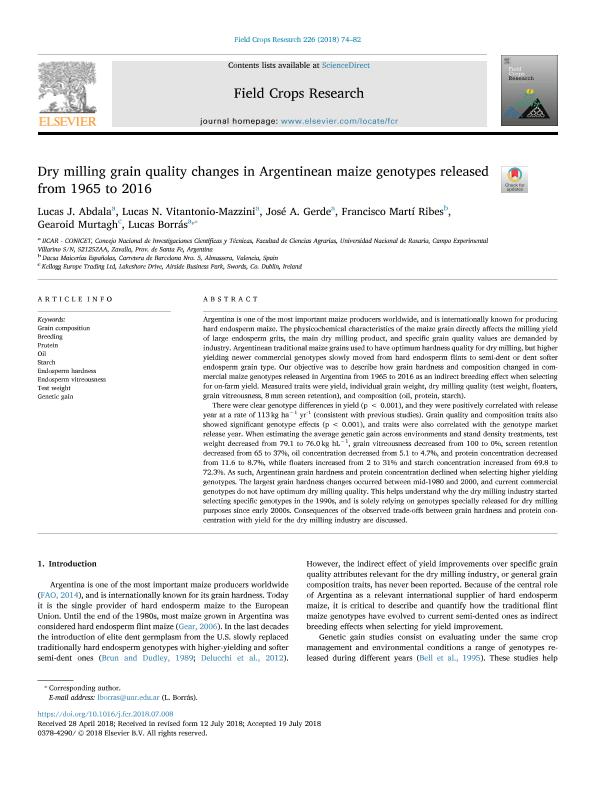Artículo
Dry milling grain quality changes in Argentinean maize genotypes released from 1965 to 2016
Abdala Alonso, Lucas Jorge ; Vitantonio Mazzini, Lucas Nicolás
; Vitantonio Mazzini, Lucas Nicolás ; Gerde, Jose Arnaldo
; Gerde, Jose Arnaldo ; Martí Ribes, Francisco; Murtagh, Gearoid; Borras, Lucas
; Martí Ribes, Francisco; Murtagh, Gearoid; Borras, Lucas
 ; Vitantonio Mazzini, Lucas Nicolás
; Vitantonio Mazzini, Lucas Nicolás ; Gerde, Jose Arnaldo
; Gerde, Jose Arnaldo ; Martí Ribes, Francisco; Murtagh, Gearoid; Borras, Lucas
; Martí Ribes, Francisco; Murtagh, Gearoid; Borras, Lucas
Fecha de publicación:
09/2018
Editorial:
Elsevier Science
Revista:
Field Crops Research
ISSN:
0378-4290
Idioma:
Inglés
Tipo de recurso:
Artículo publicado
Clasificación temática:
Resumen
Argentina is one of the most important maize producers worldwide, and is internationally known for producing hard endosperm maize. The physicochemical characteristics of the maize grain directly affects the milling yield of large endosperm grits, the main dry milling product, and specific grain quality values are demanded by industry. Argentinean traditional maize grains used to have optimum hardness quality for dry milling, but higher yielding newer commercial genotypes slowly moved from hard endosperm flints to semi-dent or dent softer endosperm grain type. Our objective was to describe how grain hardness and composition changed in commercial maize genotypes released in Argentina from 1965 to 2016 as an indirect breeding effect when selecting for on-farm yield. Measured traits were yield, individual grain weight, dry milling quality (test weight, floaters, grain vitreousness, 8 mm screen retention), and composition (oil, protein, starch). There were clear genotype differences in yield (p < 0.001), and they were positively correlated with release year at a rate of 113 kg ha−1 yr-1 (consistent with previous studies). Grain quality and composition traits also showed significant genotype effects (p < 0.001), and traits were also correlated with the genotype market release year. When estimating the average genetic gain across environments and stand density treatments, test weight decreased from 79.1 to 76.0 kg hL−1, grain vitreousness decreased from 100 to 0%, screen retention decreased from 65 to 37%, oil concentration decreased from 5.1 to 4.7%, and protein concentration decreased from 11.6 to 8.7%, while floaters increased from 2 to 31% and starch concentration increased from 69.8 to 72.3%. As such, Argentinean grain hardness and protein concentration declined when selecting higher yielding genotypes. The largest grain hardness changes occurred between mid-1980 and 2000, and current commercial genotypes do not have optimum dry milling quality. This helps understand why the dry milling industry started selecting specific genotypes in the 1990s, and is solely relying on genotypes specially released for dry milling purposes since early 2000s. Consequences of the observed trade-offs between grain hardness and protein concentration with yield for the dry milling industry are discussed.
Archivos asociados
Licencia
Identificadores
Colecciones
Articulos(IICAR)
Articulos de INST. DE INVESTIGACIONES EN CIENCIAS AGRARIAS DE ROSARIO
Articulos de INST. DE INVESTIGACIONES EN CIENCIAS AGRARIAS DE ROSARIO
Citación
Abdala Alonso, Lucas Jorge; Vitantonio Mazzini, Lucas Nicolás; Gerde, Jose Arnaldo; Martí Ribes, Francisco; Murtagh, Gearoid; et al.; Dry milling grain quality changes in Argentinean maize genotypes released from 1965 to 2016; Elsevier Science; Field Crops Research; 226; 9-2018; 74-82
Compartir
Altmétricas



